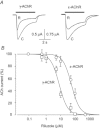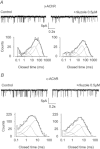Riluzole blocks human muscle acetylcholine receptors
- PMID: 22431338
- PMCID: PMC3424768
- DOI: 10.1113/jphysiol.2012.230201
Riluzole blocks human muscle acetylcholine receptors
Abstract
Riluzole, the only drug available against amyotrophic lateral sclerosis (ALS), has recently been shown to block muscle ACh receptors (AChRs), raising concerns about possible negative side-effects on neuromuscular transmission in treated patients. In this work we studied riluzole's impact on the function of muscle AChRs in vitro and on neuromuscular transmission in ALS patients, using electrophysiological techniques. Human recombinant AChRs composed of α(1)β(1)δ subunits plus the γ or ε subunit (γ- or ε-AChR) were expressed in HEK cells or Xenopus oocytes. In both preparations, riluzole at 0.5 μm, a clinically relevant concentration, reversibly reduced the amplitude and accelerated the decay of ACh-evoked current if applied before coapplication with ACh. The action on γ-AChRs was more potent and faster than on ε-AChRs. In HEK outside-out patches, riluzole-induced block of macroscopic ACh-evoked current gradually developed during the initial milliseconds of ACh presence. Single channel recordings in HEK cells and in human myotubes from ALS patients showed that riluzole prolongs channel closed time, but has no effect on channel conductance and open duration. Finally, compound muscle action potentials (CMAPs) evoked by nerve stimulation in ALS patients remained unaltered after a 1 week suspension of riluzole treatment. These data indicate that riluzole, while apparently safe with regard to synaptic transmission, may affect the function of AChRs expressed in denervated muscle fibres of ALS patients, with biological consequences that remain to be investigated.
Figures






References
-
- Bouzat C, Barrantes FJ. Modulation of muscle nicotinic acetylcholine receptors by the glucocorticoid hydrocortisone. Possible allosteric mechanism of channel blockade. J Biol Chem. 1996;271:25835–25841. - PubMed
-
- Chandu BR, Nama S, Kanala K, Challa BR, Shaik RP, Khagga M. Quantitative estimation of riluzole in human plasma by LC-ESI-MS/MS and its application to a bioequivalence study. Anal Bioanal Chem. 2010;398:1367–1374. - PubMed
Publication types
MeSH terms
Substances
LinkOut - more resources
Full Text Sources
Medical
Miscellaneous

